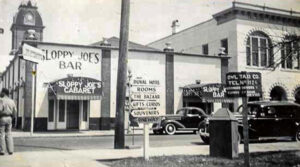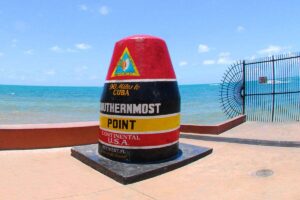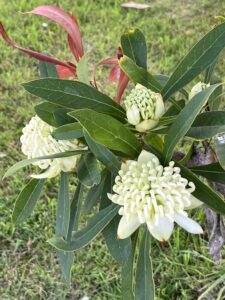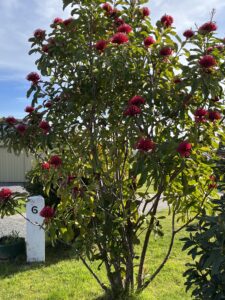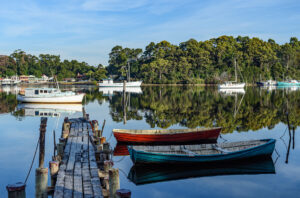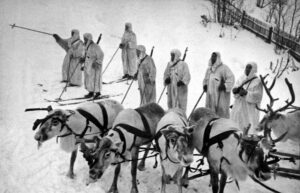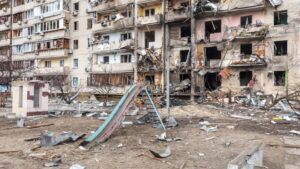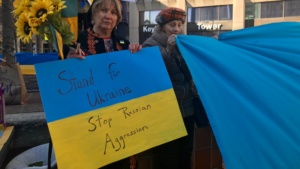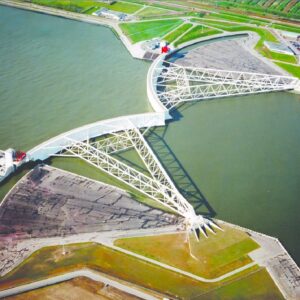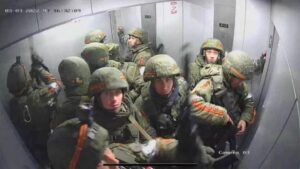I am ruminating on these 40 year old males who, as men in their early twenties, partied in the uniform of a Nazi. Presumably this act was not confined to these two guys, continents apart. It would be amazing if Harry and Dominic were the only ones among the millions of their contemporaries now in the 35-45 age group who had not at some earlier time dressed up as a Nazi for a party, night club or whatever after dark. Added to this, for even those who may not have encountered a Jew during their schooldays at Eton for Harry, or two exclusive Roman Catholic schools for the Premier, WWII was a long time past, and some children of privilege do often have the sensitivity of a warthog. Sometimes in the morning when I looked in the mirror I wondered where my tusks had gone. But that particular animal act was not part of my partying in the late 50’s and early 60s.
The well-known German artist, Anselm Kiefer, was photographed in a Nazi uniform in 1969. He had been born in 1945,(thus 24) and what he did at the time was illegal in Germany. Whether you believe that Kiefer’s interest in exploring the possibility of coming to terms with the Nazi past by transgressing post-war taboos against visual and verbal icons of the Third Reich is replete with irony, as has been stated in an apologia, is up to you. Yet this action has not cast Kiefer into the wilderness nor, to my mind, has he been pursued by members of the Jewish diaspora.
 There is a term “Nazi chic” which, as one writer wrote: “From high end designers to campy trends like “swastikawaii”, ” the iconography of Nazi style has elbowed its way through history, whether its wearers promote its ideology or not.” You see echoes of this in the uniform of those services which dress in dark leathers and buzz round on motorcycles in pursuit of the errant motorist. In fact, if you look at a photo of a German officer such as General Rommel, you see a man in a well-tailored uniform, and the fashionista that appropriate such a uniform, they do not seek meaning, rather they concentrate on appearance.
There is a term “Nazi chic” which, as one writer wrote: “From high end designers to campy trends like “swastikawaii”, ” the iconography of Nazi style has elbowed its way through history, whether its wearers promote its ideology or not.” You see echoes of this in the uniform of those services which dress in dark leathers and buzz round on motorcycles in pursuit of the errant motorist. In fact, if you look at a photo of a German officer such as General Rommel, you see a man in a well-tailored uniform, and the fashionista that appropriate such a uniform, they do not seek meaning, rather they concentrate on appearance.
Joseph Goebbels, Hitler’s propaganda chief, was very aware of the magnetic attraction of fashion in devising the Third Reich’s militarism.
As another writer says: Uniforms, which have come to be known as one of the most visually-striking elements of Nazi aesthetics, served as one of the principal vectors of propaganda in the Third Reich. In biology, a vector is an organism, typically of the biting sort, that transfers a disease from one being to another – Nazi uniforms did just that. However, instead of fleas transferring the plague, the Nazis used clothing to present propaganda that conveyed their message of racial dominance and militarism without uttering a word. Uniforms operated as an arm of the Nazi ideals of Volksgemeinschaft, in English, a people’s community and Gleichschaltung, the idea of bringing everything in line with the values of national socialism. The Nazi uniform aided in the destruction of personal identity and smoothed out the differences between German citizens thereby constructing both an egalitarian and passive society.
When I was at university, I went to many parties and there was never any question of us impersonating Nazis. We knew people who had survived the concentration camps – the number on the forearm. I clearly remember these numbers on some immigrants I met. There is nothing so shocking in seeing images of concentration camps, even if they were grainy and in black and white. I reckon that many of my contemporaries saw the same images, and there was no way we would don the swastika.
Moreover, many of our teachers had been in prisoner-of-war camps. So, impersonating the Japanese was taboo (unless cartoonish) but there was never any “Tojo chic” that I know of. The POWs may not have been gassed, but their living conditions were hellish; yet they were members of strength and they refused to relive their life in captivity – well, not in front of us who had lived through World War II as children.

Some of those who have studied this area believe the genesis of “Nazi Chic” can be attributed to the film the Night Porter, where a concentration camp survivor resumes a relationship with her Nazi captor, who is now a night porter in a Viennese hotel. It is said that Dirk Bogarde regretted his role as Night Porter, but it brought notoriety to Charlotte Rampling. What “Nazi chic” brought to the fashion-conscious uniformed services was leather – the black or grey leather jackets, leather gauntlets, leather leggings. Thus, when you pass members of the uniformed services, it is interesting to see how many of those services have adopted black shirts. Nazi Chic?
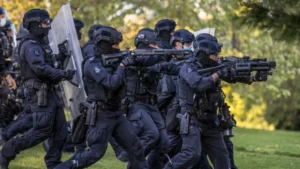
Backroads
I must say that I have been to most of the places featured on the ABC’s Backroads. Initially I resisted looking at this series, because the trailers reminded me of an endless loop of old Women’s Weeklies replete with “human stories” of a crowd of old inhabitants, the more eccentric the better, and young people making a go of it in the bush with an endless succession of dances, pubs, race meetings, and cake stalls.
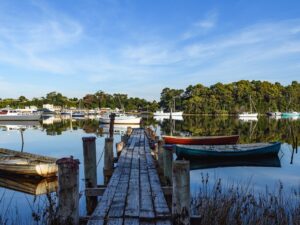
I remember that I had been told that the ABC team descended on Strahan in Tasmania, and at the end of this recent Backroads episode I wondered how enlightened the visitors would be about this little township beyond a few elegant images of a most photogenic Australian region. Stories of brutal convict prisons may be a historic backdrop, but they have next to nothing to do with the reason for Strahan’s continued existence.
And as for showing that waterskiing record; what the hell was that to do with Strahan, apart from being held there. The organisers, the Horsehead Water Ski Club, are located far from Strahan in West Kentish in Northern Tasmania, and as far as I know they have never come back – nor for that matter have I ever seen anybody waterskiing on Macquarie Harbour.
What else? The guy with the smart ocean-going yacht Stormbreaker – images of tannin-stained water, an introduction to Macquarie Harbour; images of the 1982 Franklin below Gordon River protest, which stopped a dam being built on the Gordon River, and where the Stormbreaker picks up those adventurers who kayak the river. It would have made sense for the ABC crew to have kayaked the river and been picked up by the Stormbreaker, rather than the presenter just being briefly on board with glass in hand without explaining the relevance of ecotourism to the area.
The other image of the Strahan episode was that of the Ocean Beach, and the tragedy of the periodic beaching of pilot whales and, despite all the endeavours by the locals, mortality is high. It is a recurring tragedy, and there are many bones of whales under the sands,
What was grating was the appearance of a couple of the Maunsell women wandering the Ocean Beach. They were shuffling broken shells and pieces of stone – and trying to say these are relics of Aboriginal habitation. Their contention was these were parts of a midden. The idea that a midden could survive on a beach with such ferocious storms is ridiculous. Yes, I have seen middens at Trial Harbour further up the West Coast, but not in such an exposed location as the Ocean Beach. As for fashioning stones, I have been shown an Aboriginal quarry elsewhere. Aboriginal quarries where stones were fashioned are mentioned in The Aborigines of Tasmania, H. Ling Roth’s book first published in 1890. The idea that the Aboriginals would have a quarry on a windswept beach and moreover had any use for them there strains credulity. Yet the Backroads crew fell for such nonsense.
Heather Ewart has been the main presenter and she comes across as lovable but a bit of a boofhead, who gains her rural legitimacy by being brought up in the Victorian countryside near Murchison. I was disappointed but not surprised by this last but one Backroads episode about Brunette Downs. It would have been useful to know more about the Australian Agricultural Company, which owns and operates a string of properties, feedlots and farms, comprising around 6.4million hectares of land in Queensland and the Northern Territory, including Brunette Downs. This equates to roughly one per cent of Australia’s land mass.
What made me particularly shudder was Ewart dressing up for the race meeting which is held in June each year, and which seems to have been the centrepoint of the episode – a race meeting, which was an all-white affair, aping the social calendar of metropolitan meetings.
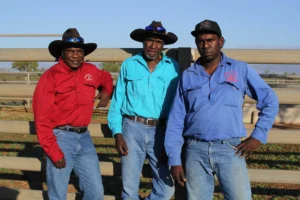 But what saddened me in watching the Brunette Downs episode, is that there seemed to be little interaction at a personal level between whitefella and blackfella. Sure as one the Aboriginal men, Elvis said working conditions had vastly improved – and one of the older white men entrusted to training the newcomers said how much he had learnt from the Aboriginal stockmen, a theme not further pursued as Backroads reverted to the Blue Hills view of the Bush.
But what saddened me in watching the Brunette Downs episode, is that there seemed to be little interaction at a personal level between whitefella and blackfella. Sure as one the Aboriginal men, Elvis said working conditions had vastly improved – and one of the older white men entrusted to training the newcomers said how much he had learnt from the Aboriginal stockmen, a theme not further pursued as Backroads reverted to the Blue Hills view of the Bush.
There was no time where blackfella and whitefella were interviewed together, which suggests that was the reality. The ABC is always footnoting everything with a statement about what “country we are on”, but the fact is that Brunette Downs is part of a business, which claims one per cent of the Australian land mass.
In 2014 the Federal Court made a momentous decision. In session in 2014 in Tennant Creek the Federal Court granted land rights (excluding mining rights) over 37,000sq km (including Brunette Downs) to the “Kulunurra (Anderson), Purrukwarra, Karrkarrkuwaja (Kalkalkuwaja), Jukatayi Palyarinji, Walanja, Kurtinja, Kuakiji/Lukkurnu, Kunapa, Jalajirrpa, Mangurinji, Kujuluwa, (Y)ijiparta, Gurungu/Kulumintini and Warranungku”. I don’t remember that being footnoted on the Backroads episode.
In the crowd that day {in 2014} were old ringers in cowboy hats and wrangler jeans and the younger men in baseball caps and urban streetwear. One elder reminisced a few men lived with him at Connells Lagoon between Brunette and Alexandria, with the women and children in town because there was no school.
He said: “Us kids were born in the saddle and we got paid in bread and beef. You can’t stay around the camp, old people had to go out and walk, out and hunt, looking out for food. They used to send us out to the stock camp, do a little work around the kitchen, helping the cook out, just for a feed. In those days we went hunting in a wagon, no motor car. We used to walk from Alex to Brunette. It was about three nights on the road, walking and a wagon just to carry a bit of swag and a bit of water.”
Those words said in 2014 voiced conditions once occurring at Brunette Downs; the same year a waterskiing record of no relevance was broken on Macquarie Harbour. In one episode of Backroads, the question of what has occurred in respect to land rights was not addressed; in the other the Backroads crowd highlighted an event of no moment to the Strahan community – yet so much of real relevance is ignored.
Is that all there is? A race meeting and a waterskiing event to characterise the essence of an Australia back road. Not a mention of land rights nor the forthcoming referendum.
In a year when there is a proposal to give the Aboriginal people a Voice – for what? To determine the horses to run on Annual Cup Day at Brunette Downs or judge the fashions on the field there?
Why not answer the question of what has giving land rights to the Aboriginal people done for those living on Brunette Downs – much more fruitful than sitting on a rock on West Strahan beach waiting for a water skier cavalcade to pass by on Macquarie Harbour. Or was that Godot?
Far Removed
People always remember those who were at school and made good – and not only made good but became a household word, hobnobbing with the rich and famous until they become the object of hobnobbery. One such person is Sir Michael Parkinson CBE.
I have a friend who came from the same village, Cudworth, as Parkinson. Yorkshire men they went to the same school – Barnsley Grammar School in Barnsley – the nearby town. Both are passionate supporters of Barnsley FC – The Tykes. They have once won the FA Cup in 1912, but currently lie mid-table in the 3rd level of the Football Association. I am sure you need to be Job to be a supporter, given the Tykes’ lack of success. That might just describe a South Yorkshire child of a coal miner. The comment was made about Parkinson’s claim that his father worked six days a week, 12 hours a day, a mile underground. One other respondent thought that a bit odd as his father had worked eight hours a day for five days a week, as his dad was a “deputy” like Parkinson’s father and believes both fathers would have been employed on similar terms.
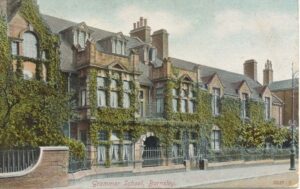
Parkinson did not endear himself to his old boy contemporaries, when he said that “Barnsley Grammar School did for education what myxomatosis did for rabbits”.
As my friend said “Every year all kids around the age of 10 years old in Barnsley and district sat examinations called the 11 plus. The top 150 boys and 150 girls were then offered places at Barnsley Grammar School for boys and the Barnsley Girls High respectively.
He went on to say: “I thought Barnsley Grammar was an excellent school with mainly good teachers and great sporting facilities. With one O Level it sounds like Parkinson was in the lower graded classes i.e. the ‘E’ stream. That’s where kids of poorer academic ability ended up. In the cruel way of school kids they were known as the ‘thickoes’ but not to their face … that could be dangerous. For Parkinson it just goes to show there’s a life without O Levels – in his case a brilliant one.
For Parkinson, in his autobiography, wrote: “I didn’t like the school and it didn’t like me. I decided at a very early age … that I didn’t want to have anything to do with the place. I wanted to leave as soon as possible.
I dropped out of the “express stream”, which fast-tracked brighter pupils into taking their O-levels a year early, and went into the A-stream. And that’s where I stayed until I left at 16 with two O-levels – in Art and Literature – to my name.
It didn’t matter to me. From the age of 12, I knew I wanted to become a journalist.
The description of the class to which Parkinson was consigned was not unusual then. This bottom class at my school in Melbourne was called ironically Remove, which was a subconscious hint to the boys in the Remove that they would languish at the bottom of the academic ladder. Hence nobody stood in their way to leave school, and then the age one could leave school was 14 years. I remember my first vacation job was just after I had turned 14 years. This one was in the public service assembling files, for which I was paid £3/6/7 a week. At least this was only a vacation job – taught me a lot, but mind numbing if you did not turn the tasks into a game.
One of the reasons one was sent to Remove was if one was hopeless at mathematics, as Parkinson admits he was. Overall, his complaint about school was the standard of the teaching staff. Generally, the poor teachers were consigned to the least academic. One of my sons was sent at one stage to remedial maths. His teacher was a guy who had been a teacher when his grandfather was at the same school. He was not much of a teacher when I remember him at school, but he provided a stern pastoral role for the boarders. By the time of my son being at school this fellow had been at the school for a good 60 years. My son realised how little the old boy knew, and his uselessness was compounded by him constantly dropping off to sleep. In other words, they were hiding a faithful servant on the edge of dementia. As my son said, he knew more mathematics than this poor old man.
Nevertheless, it is also said about poor teachers that they dislike children, and I had the experience of one teacher, who had a massive tantrum in front of the class. He sent the whole class to be caned by the Principal. It was a non-streamed class at that stage; we were not caned. After that incident he really hated us, and we were not blameless. Nevertheless, at that time, which would have roughly coincided with the time Parkinson was at school, the quality of teaching was sometimes bizarre; and some of the characters were indeed consigned to the Remove class.
But in the end, what did it matter to a guy like Parkinson, as one of his fellow old students, said.
Retreat to Cleverness?
I reckon Pelosi would not have wasted the time with such cuteness as reproduced below. This is the problem of self-conscious intellectual pretentiousness – imagining themselves as latter day Ciceros. Obama did have a bit of the rhetoric rather than action which, in the case of this guy below, does not bode well in what is going to be free-for-all legislative savagery over the next two years. For instance, what is his index for success, say of “freedom over fascism”.
Here is what he said, in part:
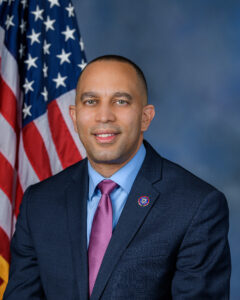
Democratic Minority Leader Hakeem Jeffries (D-N.Y.) got off to a flying start in the 118th Congress with what will forever be known as the “alphabet speech”, including this bit of acrostic poetry:
We will never compromise our principles. House Democrats will always put American values over autocracy. Benevolence over bigotry. Constitution over the cult. Democracy over demagogues. Economic opportunity over extremism. Freedom over fascism. Governing over gaslighting. Hopefulness over hatred. Inclusion over isolation. Justice over judicial overreach. Knowledge over kangaroo courts. Liberty over limitation. Maturity over Mar-a-Lago. Normalcy over negativity. Opportunity over obstruction. People over politics. Quality-of-life issues over QAnon. Reason over racism. Substance over slander. Triumph over tyranny. Understanding over ugliness. Voting rights over voter suppression. Working families over the well connected. Xenial [hospitality] over xenophobia. ‘Yes, we can’ over ‘you can’t do it,’ and Zealous representation over zero-sum confrontation.
Makes one want to weep – how bloody awful the flight of rhetoric is, from one so crucial.
Mouse whisper
I am always mildly interested in why the French call a bat – chauve souris. You know, bald mouse. First, a bat does not look like a mouse. The only mice I’ve seen hanging upside down were a couple of mates into murinyoga. Anyway, the naming is a mixup. It should be cavannus souris – night owl mouse. Has a bit more class. “Cavannus” is Gaullish Latin!


 This past week, the world has witnessed Earth based scientist intervention through The Double Asteroid Redirection Test (DART) spacecraft colliding with the asteroid Dimorphos, with the intent to change the asteroid’s orbit. The objective was achieved, in so far as it hit the target.
This past week, the world has witnessed Earth based scientist intervention through The Double Asteroid Redirection Test (DART) spacecraft colliding with the asteroid Dimorphos, with the intent to change the asteroid’s orbit. The objective was achieved, in so far as it hit the target.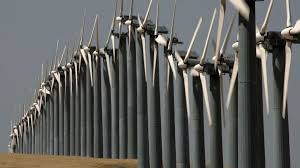
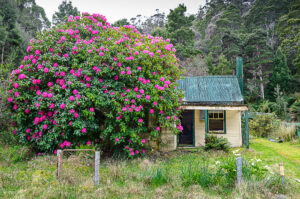 Across the road was the King River, with its sulphur stained stony and sandy shores to a river still contaminated by the tailings from the Mount Lyell mines.
Across the road was the King River, with its sulphur stained stony and sandy shores to a river still contaminated by the tailings from the Mount Lyell mines.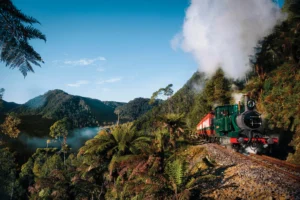
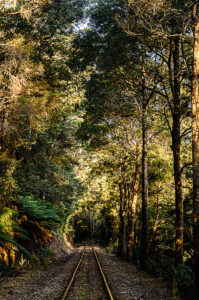 People still live along the line, but the road now ends at Lowana, where the railway line, having replaced the road, vanishes into the rain forest. Further back on the road, there is a house alongside the railway line – and close by where pastures which extend to the edge of hilly tropical forest, where the blackwood take over. Once there was a small herd of belted Galloway cattle with their distinctive magpie colour. Over the years, the animal husbandry has diversified, the Galloways have gone and the acreage, now with its collection of animals, advertises farm stays.
People still live along the line, but the road now ends at Lowana, where the railway line, having replaced the road, vanishes into the rain forest. Further back on the road, there is a house alongside the railway line – and close by where pastures which extend to the edge of hilly tropical forest, where the blackwood take over. Once there was a small herd of belted Galloway cattle with their distinctive magpie colour. Over the years, the animal husbandry has diversified, the Galloways have gone and the acreage, now with its collection of animals, advertises farm stays.